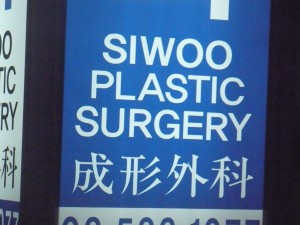Disclaimer: My last post left everyone with the promise of more frequent updates. . . ooops. Hear me out readers, I fully intended to divulge all of the experiences I have had and expose the juicy “secrets” about Korean society that my students told me. However, I found myself caught in an (internet-less) weekend trip which left me with little time to post when I got back (had to plan out that week’s class schedule/plans) followed by weekdays spent with said students even after classes were done for the day (I’m too popular I suppose). Nevertheless I’m free now so prepare yourselves to hear some amazing tales of . . . well read the title of the post. . . HERE WE GO. . . .
In one of the many meetings outside of the classroom with my wonderful students, we were in a coffee house when I noticed that a woman was wearing a surgical mask and sunglasses. Thinking little of it, I casually point her out to my students saying “oh, she must feel sick.” “No,” my students replied, “she just had plastic surgery.” Surprised, I asked my students how they knew, to which they replied that the attire of a surgical mask and large sunglasses usually indicated that someone was recovering from surgery. This seemed strange because to me this woman looked no older than 25, an opinion which I quickly voiced. “Ah,” my students said almost in unison “most people here get ‘the’ surgery done here around university age or younger” and by “the surgery” my students informed me that they were referring to “double eye-lid surgery.” My students briefly explained that Western/large eyes are coveted by many Koreans (yes, I’ve been told that gentlemen sometimes get the same procedure done) and it has become an almost customary “graduation gift” from parents to children to have the procedure done (my students have informed me that it is quite cheap and from what I’ve seen there is no shortage of plastic surgeons here). The exact steps in the procedure are unknown to me (perhaps some research shall be done), but the gist is incisions are made on both eyelids and “brow fat” is removed to create an extra layer of skin that resembles Western eyelid creases (resulting in the much-coveted “larger eyes”). I can’t help but think how strange it is that a significant percentage of people my age (my students estimated that 1 out of 5 Koreans have had this procedure, and they thought they were underestimating, especially with larger cities such as Seoul) have gone under the knife to alter their appearance; usually you hear about 40-somethings trying to keep up their youthful appearances, but from what I have heard/experienced, the “surgery craze” is about the population conforming to a idealized beauty that seeks a “Western standard.”
To summarize the “surgery craze” my students told me a (supposedly popular) joke:
“Every woman in Gangnam (Soho-like area of Seoul, also the inspiration of PSY’s catchy tune) looks identical because they’ve all gone to the same doctor.”
Above: A sign for one of the many plastic surgery offices that clutter the streets of Gagnam (L); underground/subway shopping venues where you can easily haggle a ₩10,000/$10 shirt down to ₩5,000/$5 (R)
The final topic of this post is one that still astounds me: the work ethic that the students of South Korea must exhibit while in high school. When I asked my students the hours of their typical school day in high school they told me “7am to 10”. As in 10 pm. Might I also add that many students here apparently can sign up for additional “study school” after they are dismissed at 10 pm. They eat all meals at school, to which I asked if their parents missed them while they (my students) were at school. Their response? “A little, but they knew it was necessary to get into University.” With hours like these, I asked my students if they had any comments about Western schooling systems to which one of my (quite insightful) students responded in a heartbreaking manner “when I watched Western shows as a kid and saw slumber parties and playing in the front yard, I felt envious because I knew that the childhood those children had would be one I would never experience.” Cue the foreigner tearing up in the middle of a crowded coffee shop. It is a strange thing to acknowledge as something that is a cultural “privilege,” but I have discovered a tremendous amount of gratitude for the free time (however sparse I thought it was back then) that I enjoyed after school between dinner and bedtime. How strange are the things we come to appreciate when we are away from home? Nonetheless, Korea has not ceased to amaze me, and I cannot wait to discuss topics I used to consider “normal/average/not worth discussing” all the while continuing my enjoyment in experiencing the uniqueness that is Korean culture.










